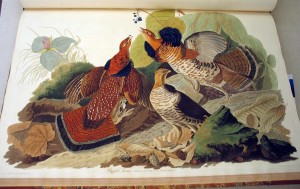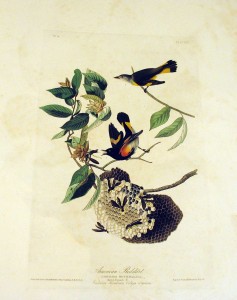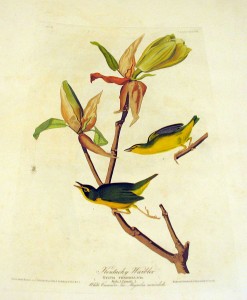 “You are now presented,kind reader, with a species of Grouse, which, in my humble opinion, far surpasses as an article of food every other land bird which we have in the United States, except the Wild Turkey, when in good condition. You must not be surprised that I thus express an opinion contradictory to that of our Eastern epicures, who greatly prefer the flesh of the Pinnated Grouse to that of the present species, for I have had abundant opportunity of knowing both . . .
“You are now presented,kind reader, with a species of Grouse, which, in my humble opinion, far surpasses as an article of food every other land bird which we have in the United States, except the Wild Turkey, when in good condition. You must not be surprised that I thus express an opinion contradictory to that of our Eastern epicures, who greatly prefer the flesh of the Pinnated Grouse to that of the present species, for I have had abundant opportunity of knowing both . . .
The names of Pheasant and Partridge have been given to the present species by our forefathers, in the different districts where it is found. To the west of the Alleghanies, and on these mountains, the first name is generally used. The same appellation is employed in the Middle Districts, to the east of the mountains, and until you enter the State of Connecticut; after which that of Partridge prevails.”
–J. J. Audubon, Ornithological Biography, I (1831), 211 [excerpted].
Comments Off on The Ruffed Grouse (Audubon “bird of the week”)
 “This is one of the most lively, as well as one of the handsomest, of our Fly-catchers, and ornaments our woods during spring and summer, when it cannot fail to attract the attention of any person who may visit the interior of the shady forests. . . .
“This is one of the most lively, as well as one of the handsomest, of our Fly-catchers, and ornaments our woods during spring and summer, when it cannot fail to attract the attention of any person who may visit the interior of the shady forests. . . .
It keeps in perpetual motion, hunting along the branches sidewise, jumping to either side in search of insects and larvae, opening its beautiful tail at every movement which it makes, then closing it, and flirting it from side to side, just allowing the transparent beauty of the feathers to be seen for a moment . . .
I have looked for several minutes at a time on the ineffectual attacks which this bird makes on wasps while busily occupied about their own nests. The bird approaches and snaps at them, but in vain; for the wasp elevating its abdomen, protrudes its sting, which prevents its being seized. The male bird is represented in the plate in this posture.”
–J. J. Audubon, Ornithological Biography, I (1831), 202-203 [excerpted].
Comments Off on American Redstart (Audubon “bird of the week”)
 “Although this smart little bird breeds in the State of Louisiana and the adjacent districts, it is not there found in so great numbers as in the Middle States, and farther to the northward. It generally prefers the depth of the forests during summer, after which it approaches the plantations, and even resorts to the granaries for corn.
“Although this smart little bird breeds in the State of Louisiana and the adjacent districts, it is not there found in so great numbers as in the Middle States, and farther to the northward. It generally prefers the depth of the forests during summer, after which it approaches the plantations, and even resorts to the granaries for corn.
. . . They move about in little companies formed of the parents and their young, eight or ten together, and escorted by the Nuthatch or the Downy Woodpecker . . .
. . . This species sometimes forms a nest by digging a hole for the purpose in the hardest wood, with great industry and perseverance, although it is more frequently contented with the hole of the Downy Woodpecker, or some other small bird of that genus. It fills the hole with every kind of warm materials, after which the female deposits from six to eight eggs, of a pure white, with a few red spots at the larger end.
. . . The species of Pine, on a twig of which you see a pair of these birds, is the White Pine (Pinus Strobus), a tree of great beauty, of which individuals have been observed of the enormous height of 180 feet, with a diameter at the base of from six to eight feet. The trunk is branchless for two-thirds of its height, and afford the most valuable wood perhaps of any tree in the United States.”
–J. J. Audubon, Ornithological Biography, I (1831), 199-200 [excerpted].
Comments Off on The Crested Titmouse (Audubon “bird of the week”)
 “This beautiful species is the most common and abundant that visits the state of Louisiana and those situated on the borders of the Mississippi. In Kentucky it is much less common, and in the state of Ohio, scarcer still. It is an extremely active and lively bird. It is found in all the low grounds and damp places near water-courses, and generally among the tall rank weeds and low bushes growing in rich alluvial soil. Continually in motion, it is seen hopping in every direction from stalk to stalk, or from one twig to another, preying upon insects and larvae, or picking small berries, seldom, however, pursuing insects on wing . . .
“This beautiful species is the most common and abundant that visits the state of Louisiana and those situated on the borders of the Mississippi. In Kentucky it is much less common, and in the state of Ohio, scarcer still. It is an extremely active and lively bird. It is found in all the low grounds and damp places near water-courses, and generally among the tall rank weeds and low bushes growing in rich alluvial soil. Continually in motion, it is seen hopping in every direction from stalk to stalk, or from one twig to another, preying upon insects and larvae, or picking small berries, seldom, however, pursuing insects on wing . . .
It arrives in the southern states, from Mexico, about the middle of March, and remains with us until the middle of September, during which time it rears two broods . . .
The branch on which two of these birds are represented, is that of the tree commonly called the White Cucumber, a species of Magnolia. It flowers as early in the season as the Dog-wood. The flowers open before the leaves are expanded, and emit an odour resembling that of a lemon, but soon becoming disagreeable, as the blossom fades. This tree seldom grows to a height of thirty feet, and is consequently disregarded as a timber-tree.”
–J. J. Audubon, Ornithological Biography, I (1831), 196-197 [excerpted].
Comments Off on The Birds are Back! The Kentucky Warbler (Audubon “Bird of the week”)
 “This is one of the most lively, as well as one of the handsomest, of our Fly-catchers, and ornaments our woods during spring and summer, when it cannot fail to attract the attention of any person who may visit the interior of the shady forests. . . .
“This is one of the most lively, as well as one of the handsomest, of our Fly-catchers, and ornaments our woods during spring and summer, when it cannot fail to attract the attention of any person who may visit the interior of the shady forests. . . .

